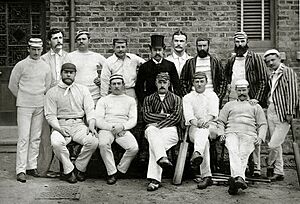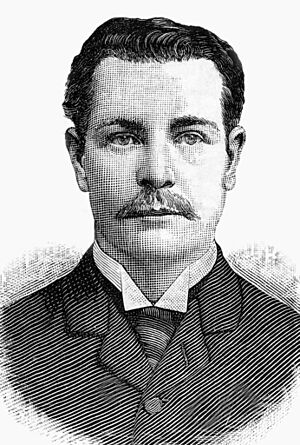Jack Worrall facts for kids
| Cricket information | ||||||||||||||||||||||||||||||||||||||||
|---|---|---|---|---|---|---|---|---|---|---|---|---|---|---|---|---|---|---|---|---|---|---|---|---|---|---|---|---|---|---|---|---|---|---|---|---|---|---|---|---|
| Batting | Right-handed | |||||||||||||||||||||||||||||||||||||||
| Bowling | Right-arm medium | |||||||||||||||||||||||||||||||||||||||
| International information | ||||||||||||||||||||||||||||||||||||||||
| National side | ||||||||||||||||||||||||||||||||||||||||
| Test debut | 1 January 1885 v England | |||||||||||||||||||||||||||||||||||||||
| Last Test | 14 August 1899 v England | |||||||||||||||||||||||||||||||||||||||
| Career statistics | ||||||||||||||||||||||||||||||||||||||||
|
||||||||||||||||||||||||||||||||||||||||
|
Source: CricInfo, 12 October 2022
|
||||||||||||||||||||||||||||||||||||||||
John Worrall (born June 20, 1861 – died November 17, 1937) was an amazing Australian athlete. He played both Australian rules football and Test cricket. He was also a very important coach in both sports. Later in his life, he became a well-known sports journalist.
Worrall was a strong and determined man. He was one of Australia's best all-round sports people in the 1800s. He played football and cricket at the highest level for many years. After he stopped playing, he coached both sports. Many people call him the "father" of Australian football coaching. He also had a long career as a sports journalist. He was highly respected by other writers until he passed away in 1937.
Contents
Early Life and Sports Beginnings
John Worrall was born in a place called Chinaman's Flat, Victoria. This was in the goldfields area. He was the seventh child of parents who came from Ireland. He went to school in Maryborough. In his early twenties, he moved to Ballarat.
In Ballarat, he played cricket against a touring English team. This led to him being chosen to play for Victoria in 1883. He also joined the South Ballarat Football Club. He was very good at football. Because of this, he was asked to move to Melbourne. There, he joined the new Fitzroy Football Club in 1884. Fitzroy had just joined the top football league, the Victorian Football Association (VFA). Worrall helped Fitzroy become a very strong team. In the summer, he played cricket for the Fitzroy Cricket Club.
One time, in 1884, Worrall was playing a cricket match. His football team, Fitzroy, needed an extra player. They asked him to play in their last game of the year. So, Worrall played the whole football match in his white cricket uniform!
Moving to Fitzroy helped Worrall a lot in both sports. He played his first Ashes Test cricket match in 1884–1885. He was called in at the last minute for that game. At this time, he was a middle-order batsman and bowled medium-pace. He didn't always get a regular spot on the Test team. He wasn't always chosen for the Victorian team either.
Football and Cricket Success
Worrall was more consistent in football than in cricket. He was already the captain of the Fitzroy team. He played as a rover, which is a fast, skilled player. He was brave and could kick with both feet. He was also great at catching the ball overhead, even though he wasn't very tall. He often played for the Victorian football team. He is one of the few people to play for Victoria in both football and cricket.

In 1888, Worrall toured England with the Australian cricket team. The weather was wet, and he found it hard to play his best. When he came back to Melbourne, he was named "The Argus Player of the Year" in 1890. He was Fitzroy's most important player during these years. In 1892, injuries made him stop playing football. This allowed him to focus more on cricket. The next year, he married Agnes McCullum.
He then joined the Carlton Cricket Club. In 1896, he scored an amazing 417 runs without being out for Carlton. This was an Australian record at the time. He changed his batting style to be more attacking. He often opened the batting but stopped bowling. He was also a great leader on the field. He was captain of the Victorian team sixteen times. He scored many big innings for Victoria. This led to him being chosen for the 1899 tour of England. He was 38 years old then. He batted with the famous Victor Trumper in all five Test matches. His best day was in the Headingley Test match. He scored 76 runs on a difficult pitch, helping Australia win. Because of his age, this was his last Test series. But he kept playing for Victoria until 1902, when he was 40.
The First Football Coach
The Carlton Football Club was very strong in the 1870s and 1880s. But by 1892, they were not doing well. Many key players left the club. This led to them finishing last in 1894. From 1895 to 1901, they often finished second-last.
In 1902, John Worrall became the secretary of the Carlton Football Club. Before Worrall, football teams didn't really have coaches. Players just trained on their own. Payments to players were not allowed, but they often happened secretly.
Worrall changed everything. He started leading training sessions. He taught players new skills and planned team strategies. He also helped find new talented players. He basically created the role of a football coach that we know today. For a few years, people called him the club's "manager" or "secretary." But soon, the word "coach" became common. Carlton's quick improvement made other clubs hire coaches too. These coaches looked up to Worrall as a role model.
Carlton quickly moved up the ladder. They made the finals in 1903, 1904, and 1905. But they didn't win the championship. Worrall's old club, Fitzroy, was the best team then. Fitzroy beat Carlton in the 1904 Grand Final. Worrall kept changing players to find the best team. He built a big, strong team that liked to kick the ball long. They also used their physical strength in crowded plays. Being fit was very important to Worrall. He made sure his team trained harder than any other team.
Finally, in 1906, Carlton beat Fitzroy in the Grand Final. They won by a record 49 points. This young team won Carlton's first championship since 1887.
Carlton then won the next two championships in 1907 and 1908. This was the first time a club won three championships in a row in the VFL. The 1908 season was the best part of Worrall's coaching career. Carlton lost only one game that year. This record has been equaled but never beaten in VFL/AFL history.
However, some disagreements started to happen. Players were getting very little money for their hard training. The club was making more money, which added to the players' concerns. Worrall was sometimes strict and had strong opinions. This made the situation worse.
In 1909, some Carlton players had disagreements with Worrall. Seven players refused to play in the first game of the season. They played against University, a team of amateur players. Even with many key players missing, University surprisingly beat Carlton.
The disagreements continued for several weeks. A small group of players wanted Worrall to resign. He did resign on July 29. He stayed on as secretary for a while. But he resigned from that role at the end of the season. Some players who supported Worrall also left the club.
After coaching VFL umpires for a season, Worrall joined the Essendon team in 1911. Essendon was talented but hadn't done well before. Worrall led them to a championship in his first season. In 1912, Essendon had many injured players. But Worrall led them to upset South Melbourne in the 1912 Grand Final. In total, Worrall coached five championship teams in five completed seasons.
Essendon's performance then declined quickly. The club even stopped playing in 1916–1917 because of World War I. When they returned, they didn't improve much. Worrall retired after the 1920 season. In 1918, Essendon finished last. This made Worrall the first person to coach both a championship team and a team that finished last.
In 1922, he briefly helped coach his old team, Fitzroy. Fitzroy went on to win the championship that year.
Journalism and Other Achievements
Worrall was very important in creating the Australian Football Council (AFC) in 1905. This group became the main organization for Australian football. It controlled the rules of the game. It also organized the first interstate carnival in 1908. Worrall was chosen as one of the representatives for Victoria. In 1909, the Victorian Cricket Association (VCA) made Worrall coach of the state's young players team. This team helped develop new talent.
Worrall started his journalism career after he stopped playing cricket. He wrote for the Sydney Referee. He wrote even more when Essendon paused playing in the VFL in 1916. He joined The Australasian newspaper. He wrote about both football and cricket. People said his writing was clear and interesting. He often compared things, shared memories, and made predictions. His writing made sports feel very exciting.
In the 1930s, he was a very important sports journalist. Many people believe he created the word "Bodyline". This word described the English bowling tactics during their 1932–1933 tour of Australia. He passed away in Fairfield, Melbourne, in 1937. He was survived by his wife. To honor Worrall, the flags at the MCG were lowered to half-mast during a cricket match. Many former players, cricketers, journalists, and officials attended his funeral.
In 1996, John Worrall was recognized for his great contributions to Australian rules football. He was added to the Australian Football Hall of Fame as a player.
See also
- List of Australian rules football and cricket players


